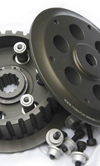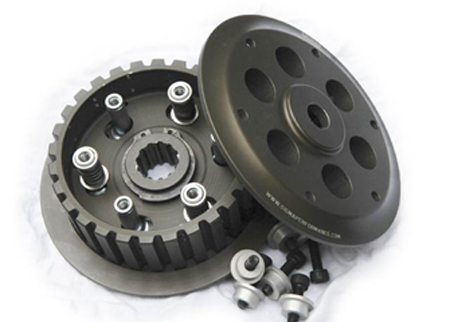Slipper clutches - coil or diaphragm?
 In a previous RET-Monitor article we looked at how these 'Back Torque Limiters' or 'Slipper Clutch' units operate, and their particular advantages in motorcycle applications. They allow a controlled slipping of the clutch until the speeds of both the rear wheel and the engine are matched, and have found their way into many motorcycle race formulae including World and British Superbike, Supermoto and even Motocross. While not exclusively suited to motorcycle applications, installing these units into bike-engined kit cars has become more commonplace.
In a previous RET-Monitor article we looked at how these 'Back Torque Limiters' or 'Slipper Clutch' units operate, and their particular advantages in motorcycle applications. They allow a controlled slipping of the clutch until the speeds of both the rear wheel and the engine are matched, and have found their way into many motorcycle race formulae including World and British Superbike, Supermoto and even Motocross. While not exclusively suited to motorcycle applications, installing these units into bike-engined kit cars has become more commonplace.
In motorcycle clutch units there are two main methodologies of assuring the pressure plate compresses the clutch plates when the clutch lever is de-pressed, namely using either a series of coil springs or sets of diaphragm-type springs. But which is more suitable? Depending on the manufacturer, OEM and aftermarket clutches can take the form of either type in order to satisfy a variety of criteria including the feel of the clutch, compatibility, adjustability, manufacturability and durability. While coil spring units find their home in most British Superbike teams, many World Superbike teams have favoured the diaphragm spring alternative. From both a manufacturer and customer view point, there are a number of areas to consider.
Within the coil sprung unit, depending on the number of springs used in the clutch unit, changing and varying the spring rates among the set allows an almost infinite degree of adjustability, and enables the user to determine the amount of engine braking or slip required from the clutch, as well as allowing the capability to maintain consistent performance as the clutch pack wears. In addition, some have reported that the coil spring can give a more linear clutch lever feel due to the nature of the spring rate as it is compressed.
On the dirt bike scene, particularly in Enduro events, many riders of the 450 cc four-strokes - chiefly the Honda - have found extra longevity and resistance to clutch fade by replacing the standard four-coil spring unit with an aftermarket six-spring unit, due to a more uniform loading of the clutch plates. Further reduction in fade and greater resistance to stalling have been found by replacing the OEM unit with a Back Torque Limiter, not only through the benefits afforded by the device but by providing additional oil flow through the clutch unit and consequently more effective cooling.

The diaphragm spring units, specifically the STM unit, typically contains two diaphragm-type springs, by replacing the secondary spring to vary the level of engine braking, and the primary spring allows the level of slippage under acceleration to be maintained - for instance, if power output was increased, the spring tension could also be increased to help maintain clutch engagement under hard acceleration.
From a manufacturing point of view, providing a multitude of spring rates could cause headaches; forming ribs within the springs' 'fingers' is one way to increase clamping force, though this method alone would require significant and costly tooling requirements. Diaphragm springs have enabled clutch designs to become more compact and maintain a light clutch actuation, not only within the motorcycle industry but across the automotive industry. Also, because of the nature of the spring design, fatigue failure could be problematic but spring design, along with metallurgy advances, have improved performance. Although we have yet to delve further into cost or supplier loyalty, there is clearly a lot of food for thought.
Fig. 1 - A Sigma performance 'Slipper clutch' coil spring unit for a Honda CRF 450, showing the clutch centre and the amount of rotational movement available
Written by Chris Thwaites